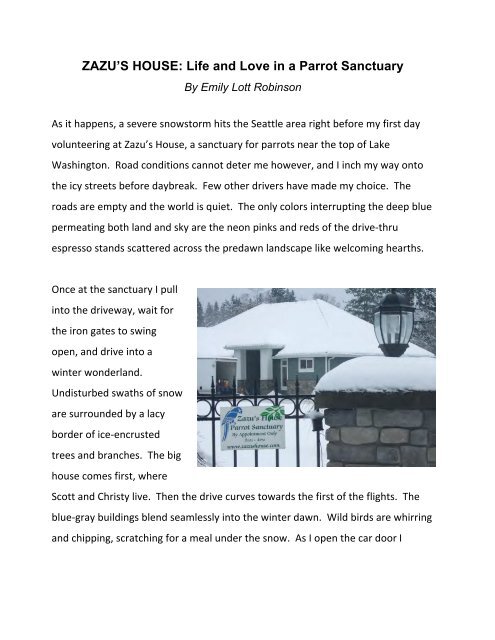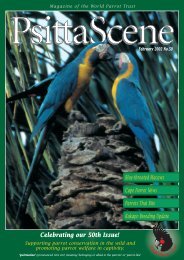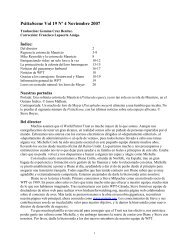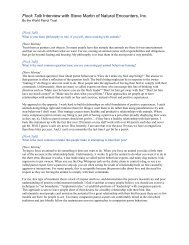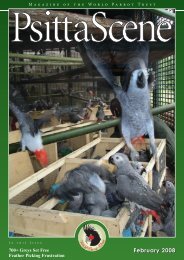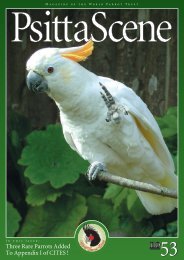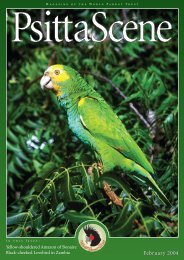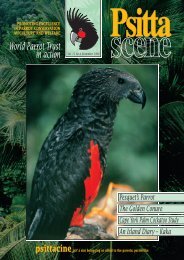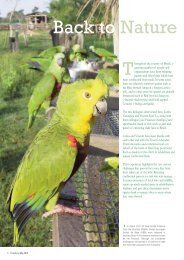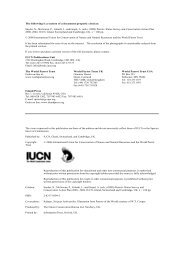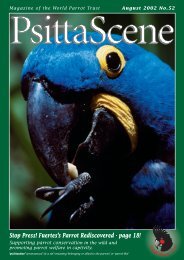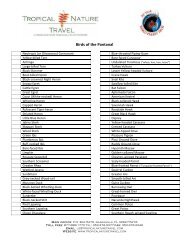Read the story (PDF) - World Parrot Trust
Read the story (PDF) - World Parrot Trust
Read the story (PDF) - World Parrot Trust
You also want an ePaper? Increase the reach of your titles
YUMPU automatically turns print PDFs into web optimized ePapers that Google loves.
ZAZU’S HOUSE: Life and Love in a <strong>Parrot</strong> Sanctuary<br />
By Emily Lott Robinson<br />
As it happens, a severe snowstorm hits <strong>the</strong> Seattle area right before my first day <br />
volunteering at Zazu’s House, a sanctuary for parrots near <strong>the</strong> top of Lake <br />
Washington. Road conditions cannot deter me however, and I inch my way onto <br />
<strong>the</strong> icy streets before daybreak. Few o<strong>the</strong>r drivers have made my choice. The <br />
roads are empty and <strong>the</strong> world is quiet. The only colors interrupting <strong>the</strong> deep blue <br />
permeating both land and sky are <strong>the</strong> neon pinks and reds of <strong>the</strong> drive-‐thru <br />
espresso stands scattered across <strong>the</strong> predawn landscape like welcoming hearths. <br />
Once at <strong>the</strong> sanctuary I pull <br />
into <strong>the</strong> driveway, wait for <br />
<strong>the</strong> iron gates to swing <br />
open, and drive into a <br />
winter wonderland. <br />
Undisturbed swaths of snow <br />
are surrounded by a lacy <br />
border of ice-‐encrusted <br />
trees and branches. The big <br />
house comes first, where <br />
Scott and Christy live. Then <strong>the</strong> drive curves towards <strong>the</strong> first of <strong>the</strong> flights. The <br />
blue-‐gray buildings blend seamlessly into <strong>the</strong> winter dawn. Wild birds are whirring <br />
and chipping, scratching for a meal under <strong>the</strong> snow. As I open <strong>the</strong> car door I
immediately hear <strong>the</strong> coarse calls of <strong>the</strong> macaws in <strong>the</strong> Big Flight, an echo from <strong>the</strong> <br />
primordial jungle splitting open <strong>the</strong> Northwest sky. <br />
I pick my way cautiously over <strong>the</strong> frozen gravel path and enter <strong>the</strong> double doors of <br />
<strong>the</strong> Big Flight. Long-‐tailed shapes loom in <strong>the</strong> tops of giant trees, and as my eyes <br />
get accustomed to <strong>the</strong> dim morning light, a carnival of colors emerges like an <br />
exploded piñata. Brilliant reds, blues, greens, and yellows shine down <br />
unapologetically from <strong>the</strong> rafters, undefiled by <strong>the</strong> bars of a cage. I sense <br />
hundreds of examining eyes swiveling towards me, and after a brief moment of <br />
silence, a chorus of “helloes” rains down in high raspy voices. <br />
Zazu’s House was founded <br />
in 2000 by Scott & Christy <br />
Hensrude, made possible <br />
by <strong>the</strong> financial success of <br />
an auto body business <strong>the</strong>y <br />
established and built <br />
toge<strong>the</strong>r. The sanctuary <br />
for parrots (mostly <br />
macaws) lies sequestered <br />
inside a wooded twelve-‐acre plot. Bald eagles soar overhead, on <strong>the</strong>ir way to and <br />
from <strong>the</strong>ir nests on <strong>the</strong> nearby lakes, and bears and cougars are not uncommon <br />
visitors. The woods around <strong>the</strong> sanctuary provide a convenient source of perching <br />
and chewing fodder for <strong>the</strong> voracious macaws. There are two main flights; one <br />
2 ZAZU’S HOUSE BY EMILY LOTT ROBINSON
(“Special Needs”) houses about forty of <strong>the</strong> smaller birds and <strong>the</strong> more challenging <br />
cases. <br />
The “Big Flight” was constructed in 2010 using volunteer labor and donated <br />
materials to accommodate <strong>the</strong> growing flock of macaws, which has now reached <br />
one hundred or more. The Hensrudes make use of recycled materials whenever <br />
possible, and find a way to <br />
use every donated item <br />
that comes <strong>the</strong>ir way. “If <br />
we can’t use it, we’ll give it <br />
to one of <strong>the</strong> o<strong>the</strong>r local <br />
sanctuaries,” Christy says. <br />
The discarded seed mix is in <br />
turn donated to sanctuaries <br />
for pigs, and local chicken <br />
and duck flocks. Nothing <br />
goes to waste, even inadvertently: an impromptu field of sunflowers, millet and <br />
pumpkins sprang to life from leftover seeds thrown out onto a hillside—a <br />
Northwest rendition of <strong>the</strong> important role parrots play in <strong>the</strong> life cycle of <strong>the</strong>ir <br />
native rainforests. <br />
Operating costs are immense. Christy forages for surplus stock from seed factories <br />
whenever possible. After her overtures to o<strong>the</strong>r grocery stores were rejected, she <br />
persuaded a nearby Costco to let her take <strong>the</strong>ir overstock of fruit for <strong>the</strong> birds. <br />
Avian veterinarian Dr. Elizabeth Kamaka provides much of <strong>the</strong>ir medical care pro
ono. There is no paid labor; <strong>the</strong>y rely utterly on <strong>the</strong>ir own resources and on <br />
volunteer assistance. Never<strong>the</strong>less, donated time and materials cover only a small <br />
portion of <strong>the</strong> total costs of running <strong>the</strong> sanctuary. After heating, water, medical <br />
and o<strong>the</strong>r costs are calculated, Christy estimates that <strong>the</strong>y spend approximately <br />
three thousand dollars per month to keep and care for <strong>the</strong> birds—most of which <br />
comes straight out of Scott and Christy’s generous pockets. <br />
Christy is a beautiful woman whose <br />
manicured features and impeccable hair <br />
make her look as though she has just <br />
stepped off a pageant runway. As I wipe <br />
off <strong>the</strong> sweat and dust and grime I accrete <br />
after just a few hours of working with <br />
<strong>the</strong>se birds, I crave to know by what <br />
miracle she is able to keep up her <br />
appearance while living within feet of one <br />
hundred and fifty parrots, let alone <br />
working with <strong>the</strong>m every day! Nei<strong>the</strong>r <br />
Hensrude grew up with birds, although <br />
Christy was an animal lover from childhood. Their love affair with parrots began, <br />
as Christy describes it, when <strong>the</strong>y walked into a pet store intending to buy a turtle <br />
for <strong>the</strong>ir son and instead walked out with two macaws. They wanted <strong>the</strong>ir birds <br />
Howard and Zazu to have a high-‐quality, free-‐flying life, so constructed a large <br />
indoor-‐outdoor aviary next to <strong>the</strong>ir own house to accommodate <strong>the</strong> birds’ flying <br />
needs. They adopted <strong>the</strong>ir first seven avian refugees from ano<strong>the</strong>r rescue <br />
4 ZAZU’S HOUSE BY EMILY LOTT ROBINSON
operation that had been forced to shut down. Over time this number has swelled <br />
to well over one hundred fifty birds, mostly macaws but a handful of Amazons, <br />
African Greys, and o<strong>the</strong>r parrots as well. <br />
Christy knows every bird in <strong>the</strong> sanctuary by sight. They know her, too. When she <br />
enters <strong>the</strong> flight a huge uproar commences—a greeting fit for a Titania or <strong>the</strong> <br />
Queen Mo<strong>the</strong>r, and matched only by <strong>the</strong> din when she leaves. Christy accepts <br />
only birds personally referred to her from a vet or o<strong>the</strong>r rescue. Most of <strong>the</strong> birds <br />
come from loving though not always perfect homes. “No one expects to get <br />
cancer, get divorced, lose <strong>the</strong>ir job, lose <strong>the</strong>ir house,” Christy says. “I’ve hugged <br />
owners who were bawling as <strong>the</strong>y left <strong>the</strong>ir birds.” O<strong>the</strong>rs truly have <strong>the</strong> best <br />
interests of <strong>the</strong>ir parrot at heart. “They <br />
feel <strong>the</strong>ir birds are not happy, and <strong>the</strong>y <br />
want <strong>the</strong>m to be happy.” Some owners <br />
who return for <strong>the</strong>ir birds are hurt when <br />
<strong>the</strong>ir baby does not want to leave Zazu’s—<br />
sometimes physically. One owner was <br />
badly bitten by her parrot as she tried to <br />
carry it out of <strong>the</strong> flight. “It was just like a <br />
small child,” Christy explains, “It didn’t <br />
want to leave its friends!” <br />
This does not mean all of <strong>the</strong> parrots at Zazu’s come from wonderful loving homes. <br />
Many owners do not understand <strong>the</strong>ir bird’s needs, thinking that if <strong>the</strong> bird bites <br />
when <strong>the</strong>y try to step <strong>the</strong>m up, it means <strong>the</strong>y want to stay in <strong>the</strong>ir cage. “They
don’t see it as abuse to leave <strong>the</strong>m in <strong>the</strong>ir cage all <strong>the</strong> time,” explains Christy. <br />
“They think <strong>the</strong>y’re doing what <strong>the</strong> bird wants.” One sadly plucked Severe Macaw, <br />
“Lovey,” suffers from permanent kidney and liver damage due to <strong>the</strong> ice-‐cream-and-‐peanut-‐butter<br />
diet supplied by its overindulgent caregiver. But Christy does <br />
not judge. “These people aren’t giving up <strong>the</strong>ir birds because <strong>the</strong>y don’t love <br />
<strong>the</strong>m,” she says. No, in too many cases it is because <strong>the</strong>y love <strong>the</strong>m too much. <br />
* * * * * <br />
My job as a volunteer is to help <br />
feed, water, and clean up after <br />
<strong>the</strong>se birds. I have never been <br />
inside Zeus’s stables, but I <br />
guarantee his horses are no <br />
match for one hundred macaws. <br />
The Big Flight is a four thousand-square-‐foot,<br />
ca<strong>the</strong>dral-‐sized <br />
structure, every inch of which is <br />
littered with seed husks, fruit rinds and poop. I wear an ancient sweatshirt, torn <br />
jeans, and a kerchief over my hair for obvious reasons. I maneuver a janitor’s cart <br />
around <strong>the</strong> flight and refill trays on raised platforms with food, clean water and <br />
fresh fruit. The trays must be fixed securely in place; o<strong>the</strong>rwise <strong>the</strong>se enterprising <br />
birds will waste no time in dumping <strong>the</strong> entire contents onto <strong>the</strong> ground. After <strong>the</strong> <br />
rounds, <strong>the</strong> entire flight must be scraped of droppings and swept. The whole <br />
process consumes several hours and a goodly amount of physical strength—and <br />
6 ZAZU’S HOUSE BY EMILY LOTT ROBINSON
doesn’t even begin to address <strong>the</strong> entire amount of work that caring for <strong>the</strong>se <br />
birds requires. <br />
On my first day at Zazu’s, a Blue and Gold Macaw introduces herself: “Meekah <br />
Meekah Meekah,” she announces, bobbing her head up and down. She promptly <br />
hops onto my cart and hitches a ride. She accompanies me <strong>the</strong> entire time, <br />
making sure I am doing everything correctly, defending me from <strong>the</strong> o<strong>the</strong>r birds, <br />
and chattering away nonstop in indistinct mumblings. Her favorite phrase besides <br />
her name is, “I love you!” O<strong>the</strong>r parrots introduce <strong>the</strong>mselves as well (“You’re a <br />
good boy Gilbert”). Most merely eye me curiously from <strong>the</strong>ir selected perch high <br />
in <strong>the</strong> huge live trees inside <strong>the</strong> flight. Some nimbly climb down fat ropes and <br />
demand, “Step up!” O<strong>the</strong>rs, like <br />
Mollie, try a more direct approach and <br />
attempt to swoop down onto my <br />
shoulder, emitting a merciless shriek <br />
like a harpy eagle. A few mischievous <br />
types will creep up and chew at my <br />
shoelaces when I’m distracted. One <br />
pair of Blue & Golds are busy nest-building<br />
in a corner. As I pass by with <br />
my cart, one waddles over ferociously as <strong>the</strong> o<strong>the</strong>r calmly continues excavating its <br />
hole in <strong>the</strong> wall. Ano<strong>the</strong>r pair decide to set up camp inside <strong>the</strong> box of food mix on <br />
my cart. They don’t like my taking any of “<strong>the</strong>ir” food away though, so I have to <br />
evict <strong>the</strong>m using a long stick we carry around for such purposes. The female <br />
doesn’t like this at all, and wreaks her revenge by ripping off my headscarf when I
am not looking. Exceedingly pleased with herself, she waves it triumphantly back <br />
and forth like a trophy of war until she gets bored and drops it. <br />
By <strong>the</strong> time I finish <strong>the</strong> rounds on my first day, I have reached that frightening <br />
stage of fatigue that deflates every cell in my body, and reduces my patience level <br />
to that of an infant. My arms and legs are shaking with exhaustion, my neck aches, <br />
my eyes sting. I know I had better leave for home quickly because I don’t even <br />
have enough energy reserves <br />
for polite conversation. I drive <br />
home bleary-‐eyed, take care of <br />
<strong>the</strong> basic needs of my own two <br />
parrots, and take a long hot <br />
shower, and a mouthful of pain <br />
reliever. I have no energy for <br />
anything at all for two full days, <br />
including being nice to my <br />
husband. “This must be what <br />
janitors go through,” I realize, with a newly fervent appreciation for people who <br />
perform hard labor on a daily basis. As time went on however <strong>the</strong> excessive <br />
fatigue has waned, and I’m now able to recover most physical and social skills by <br />
<strong>the</strong> end of <strong>the</strong> day. <br />
On my second visit Meekah does not accompany me but shouts “I love you!” from <br />
her perch on one of <strong>the</strong> food troughs. Instead I make new friends-‐-‐one Blue & <br />
Gold in particular who follows me around <strong>the</strong> flight, repeating, “Hello!” insistently <br />
8 ZAZU’S HOUSE BY EMILY LOTT ROBINSON
until I step him up. I’m a classical singer by day, and couldn’t resist testing a few of <br />
my operatic vocalizes in <strong>the</strong> Big Flight to hear <strong>the</strong> acoustics and see how <strong>the</strong> birds <br />
react. It is a surreal experience to hear <strong>the</strong> raucous birds fall silent as <strong>the</strong>y listen, <br />
trying to diagnose this mysterious new sound. After about fifteen seconds <strong>the</strong>y <br />
must figure it out because <strong>the</strong>y pick up right where <strong>the</strong>y left off. As I finish my <br />
work and leave <strong>the</strong> flight, one eerily human voice says cheerfully, “See you later!” <br />
The Special Needs flight houses not only <strong>the</strong> smaller birds but also <strong>the</strong> serious <br />
pluckers and <strong>the</strong> handful of birds who must be caged due to <strong>the</strong>ir over-‐aggressive <br />
behavior (illness or posing a danger to o<strong>the</strong>rs are <strong>the</strong> only reasons a bird is caged <br />
at Zazu’s House). One pair of Blue & Golds are particularly zealous biters. I call <br />
<strong>the</strong>m “<strong>the</strong> Bad Boyz.” We have a game of sorts: I attempt to change <strong>the</strong>ir food and <br />
water bowls, and <strong>the</strong>y try to bite my fingers off. I try a new evasion strategy every <br />
visit and <strong>the</strong>y parry with <strong>the</strong>ir own, a kind of medieval arms race through <strong>the</strong> bars <br />
of a parrot cage. <br />
Mainly <strong>the</strong>ir antics just make me laugh. But one day as I am wrangling with <strong>the</strong> <br />
Bad Boyz my finger gets too close. Lightning-‐quick, Bad Boy #1 somehow wedges <br />
his beak through <strong>the</strong> bars and slices open <strong>the</strong> tip of my left forefinger just below <br />
<strong>the</strong> nail. His beak is so sharp it doesn’t hurt, but blood is escaping fast so I squeeze <br />
a thick towel around <strong>the</strong> slice and hike off to <strong>the</strong> first aid kit in <strong>the</strong> next building to <br />
bandage myself up. I can tell it is bad. I don’t want to abandon my work though, <br />
so I wrap my finger up in gauze as tightly as I can, layer on scads of bandages, and <br />
pray that <strong>the</strong> bleeding stops of its own accord. I manage to finish my rounds (not <br />
easy with one mummified forefinger), but even after I get home hours later <strong>the</strong>
leeding has not slowed. I do not have time to go to <strong>the</strong> hospital for stitches so I <br />
perform my best attempt at staunching <strong>the</strong> flow and will <strong>the</strong> bleeding to stop with <br />
all my might. After about four hours it does, but it will be three weeks before <strong>the</strong> <br />
wound is healed, and Bad Boy #1 has left a permanent half-‐moon-‐shaped scar on <br />
my hand. Still, I don’t hold a grudge—how can I? It is a game for <strong>the</strong>m, nothing <br />
more. <br />
Bitten fingers and aching limbs <br />
notwithstanding, I eagerly <br />
anticipate my volunteer <br />
session every week. The <br />
sanctuary is a magical place <br />
for me, inhabited by colorful <br />
spirits that sublimate my <br />
physical suffering and <br />
transport me to a higher <br />
plateau of existence. For some reason <strong>the</strong> parrots’ obvious indifference to my life <br />
widens my perspective, helping me to transcend my own petty frustrations and <br />
sorrows. On some days I’m not sure who is helping whom. I am reminded of giant <br />
trees in ancient forests, or <strong>the</strong> columns in <strong>the</strong> great gothic ca<strong>the</strong>drals of Europe: <br />
while humans scurry around at <strong>the</strong>ir feet, distracted by <strong>the</strong>ir short turbulent lives, <br />
<strong>the</strong>se axes mundi stand unaffected, uncaring and unchanging. The parrots, shining <br />
brightly in <strong>the</strong>ir treetops, invite <strong>the</strong> eye upwards, away from <strong>the</strong> mire of terrestrial <br />
concerns and towards some enchanting celestial sphere. <br />
* * * * * <br />
10 ZAZU’S HOUSE BY EMILY LOTT ROBINSON
My immediate supervisor is Roy. Roy is a tough old lion, a sort of hybrid between <br />
Saint Francis and Saint Nick. Roy had never owned a parrot before becoming <br />
facilities manager at Zazu’s, but he has always shared his home with animals: dogs, <br />
goats, a pot-‐bellied pig. Roy is not paid; as caretaker he lives rent-‐free in decent <br />
quarters on <strong>the</strong> sanctuary grounds which is his only compensation. When he first <br />
started volunteers were scarce, and he was responsible for all of <strong>the</strong> feeding, <br />
cleaning, fruit-‐cutting, scraping, sweeping, laundry, maintenance of cages, toys, <br />
and structures, restocking supplies, and garbage disposal—all this along with <strong>the</strong> <br />
vital task of providing companionship to <strong>the</strong>se orphaned parrots. He is on call 24-‐7 <br />
for emergencies and deliveries. There are no days off at this job, and no sick days. <br />
“The first week I felt too tired to get up in <strong>the</strong> morning,” he admits. More <br />
volunteers are available to help now, but <strong>the</strong> vast majority of <strong>the</strong> work still falls to <br />
Roy. When I asked him how many times he has been bitten he says, wryly, <br />
“Hundreds.” <br />
Roy freely confesses that he never was a bird person. I ask him how he sees <br />
parrots now, after living with <strong>the</strong>m in close quarters for several months, exposed <br />
to <strong>the</strong>ir impish tricks and <strong>the</strong>ir magic. He replies, “Pretty much <strong>the</strong> same way as <br />
before—<strong>the</strong>y’re noisy, messy and destructive!” And yet, I’ve seen Roy take a bird <br />
on his hand, and sit with it for an hour; spend hours on rigorous cleaning; bandage <br />
a bleeding finger and head right back into <strong>the</strong> maelstrom. He tells me <strong>the</strong> <strong>story</strong> of <br />
Fiesta, an appropriately named Fiesta Macaw who followed him around constantly <br />
when he first came to Zazu’s. Fiesta was a biter. As Roy says, “He didn’t do it out <br />
of malice—he just didn’t know how to do anything else.” Fiesta flew after Roy <br />
constantly, clinging to <strong>the</strong> nearest window grate as he worked his way around <strong>the</strong>
Big Flight. As <strong>the</strong> bird became more intrigued by Roy, he would fly to <strong>the</strong> ground <br />
at his feet, and climb up his legs all <strong>the</strong> way to his shoulder—a convenient <br />
launching pad for more biting. This pattern continued for several weeks, until one <br />
day Fiesta flew to <strong>the</strong> ground at Roy’s feet and waited expectantly until Roy <br />
stepped him up onto his hand for <strong>the</strong> first time. Roy explains that <strong>the</strong>y two of <br />
<strong>the</strong>m now have “an understanding”; Fiesta has learned that biting is not <strong>the</strong> only <br />
form of interaction, and Roy agrees to suffer <strong>the</strong> occasional bite as an acceptance <br />
of this bird’s individual character. <br />
Roy is not a bird person. He does not have a deep love of or fascination with <br />
parrots. He devotes his time and lifeblood to <strong>the</strong> task of caring for <strong>the</strong>se outcasts <br />
because he feels that we have a duty towards <strong>the</strong>se creatures who did not ask to <br />
become part of our lives, yet who were brought into <strong>the</strong>m for our enjoyment and <br />
abandoned when <strong>the</strong>ir keeping became too difficult or inconvenient. Roy feels an <br />
unquestioned sense of responsibility to help animals in need. In his view, a <br />
commitment has been breached, and he as a member of <strong>the</strong> human race has an <br />
obligation to make amends for o<strong>the</strong>rs’ failures. To Roy, this duty seems self-evident.<br />
<br />
* * * * * <br />
The third major figure at Zazu’s House is Christy’s husband Scott. Aware of <strong>the</strong> <br />
stress cracks that even one parrot can inflict on a marriage, I ask Christy how Scott <br />
feels about this massive refuge operation. She assures me that he is fully on <br />
board, that “he enjoys seeing <strong>the</strong> birds become happy.” She relates <strong>the</strong> <strong>story</strong> of <br />
Francine, an ailing Blue & Gold Macaw <strong>the</strong>y took into <strong>the</strong>ir own living space who <br />
died only recently. Francine fell head over heels in love with Scott as soon as she <br />
12 ZAZU’S HOUSE BY EMILY LOTT ROBINSON
moved in and would scream constantly if he were in <strong>the</strong> house but not holding <br />
her. “If he wanted to be alone he would have to crawl into <strong>the</strong> house on his hands <br />
and knees to avoid being detected,” Christy recalls. When Francine’s health <br />
declined to <strong>the</strong> point where her feet atrophied, <strong>the</strong>y brought her to <strong>the</strong> vet who <br />
confirmed that she was near <strong>the</strong> end. She offered to euthanize her but <strong>the</strong>y <br />
couldn’t do it. “She wasn’t in pain,” Christy says, “and we wanted to be with her.” <br />
She points at <strong>the</strong> brown lea<strong>the</strong>r armchair where Scott sat all day with Francine <br />
lying on his chest, her head nestled against his neck. When he was forced to get <br />
up he would hand her gently to Christy, but Francine would tug her head towards <br />
Scott in a feeble attempt to get back to him. Late in <strong>the</strong> afternoon she died. This <br />
was several months ago, but Christy still cries as she tells <strong>the</strong> <strong>story</strong>. <br />
“I was born to be a shepherd of animals,” Christy says when I ask about her own <br />
hi<strong>story</strong>. “Scott thought I was crazy when I would make him pull <strong>the</strong> car over to <br />
help an animal on <strong>the</strong> side of <strong>the</strong> road.” She is devoutly religious and feels <br />
fortunate to be able to support both animals and people in need with <strong>the</strong> <br />
resources garnered from <strong>the</strong>ir small business. Before establishing Zazu’s House, <br />
<strong>the</strong>y supported a charity that pairs birds with troubled children, giving <strong>the</strong>m <br />
something to love, and creating a relationship beneficial to both. For Christy, <br />
<strong>the</strong>re is no Great Divide between helping animals and helping people. When I ask <br />
her whe<strong>the</strong>r some people don’t criticize <strong>the</strong>ir choice to devote so much time and <br />
money to <strong>the</strong>se birds she seemed confused by <strong>the</strong> question. “We help both,” she <br />
answers. She does not view <strong>the</strong> situation as ei<strong>the</strong>r/or—which makes me wonder <br />
why so many o<strong>the</strong>r people do.
Her life is often a struggle. “I lift hundreds of pounds every day,” she says. “I’m <br />
covered with cuts and bruises, and my whole body aches by evening.” Taking time <br />
for vacation and travel is difficult. Hardest for Christy is when her family feels <br />
marginalized, resenting all of <strong>the</strong> time she must spend with <strong>the</strong> parrots. Still, she <br />
firmly believes God has made it clear that this is her mission in life. <br />
* * * * * <br />
One day as I forced <strong>the</strong> cart around a corner in <strong>the</strong> Big Flight, I froze. Just ahead, a <br />
splash of color lay on <strong>the</strong> ground like spilled red, yellow and blue paint. It was a <br />
Scarlet Macaw, ei<strong>the</strong>r dead or near death. She lay on her breast, wings spread <br />
against <strong>the</strong> cold cement floor—a stereotypical image of a macaw in flight, except <br />
that her eyes were closed. Not sure what to do, I went to find Christy, who <br />
immediately dropped her work and ran back with me to <strong>the</strong> flight. She gently <br />
lifted <strong>the</strong> bird. “She’s still alive, she’s still alive!” she exclaimed, and hurried out of <br />
<strong>the</strong> flight with <strong>the</strong> Scarlet cradled in her arms like a baby as <strong>the</strong> o<strong>the</strong>r macaws in <br />
<strong>the</strong> flight initiated a huge rawking alarm. <br />
As I watched her rush out, murmuring endearments to <strong>the</strong> dying bird clasped to <br />
her chest, I realized something I hadn’t before. There are certain people in <strong>the</strong> <br />
world who voluntarily expose <strong>the</strong>mselves to death and pain and <strong>the</strong> evils wrought <br />
by nature and human nature, such as doctors, veterinarians, and people who <br />
devote <strong>the</strong>ir entire lives to defending species from almost-‐certain extinction. For <br />
some reason I’ve always assumed that <strong>the</strong>se people only manage to do what <strong>the</strong>y <br />
do because <strong>the</strong>y don’t care as much as many of <strong>the</strong> rest of us—because <strong>the</strong>y have <br />
found some way to harden <strong>the</strong>ir hearts to <strong>the</strong> suffering and casualties of human <br />
ignorance <strong>the</strong>y witness on a daily basis. <br />
14 ZAZU’S HOUSE BY EMILY LOTT ROBINSON
I can’t speak for all of <strong>the</strong>m, but clearly, Christy does care. She suffers <strong>the</strong> abuse, <br />
illness and death of each individual bird, and continues her mission anyway. <br />
Inspiring indeed to those of us who use our fear of emotional pain as an excuse to <br />
do less than we o<strong>the</strong>rwise might. I realized that, in <strong>the</strong> end, people like Roy, Scott <br />
and Christy do what <strong>the</strong>y do out of love—and love, as we know, can inspire one to <br />
Herculean feats. <br />
* * * * * <br />
After my rounds are complete, I empty <strong>the</strong> dirty dishwater, restock <strong>the</strong> food mix, <br />
wash <strong>the</strong> fruit bowls, throw <strong>the</strong> towels in <strong>the</strong> laundry and wipe down <strong>the</strong> cart. I’m <br />
filthy, my back aches, my vision is blurry, my ears are ringing. Insensible to my <br />
pain, <strong>the</strong> birds are happily rummaging through today’s offerings, performing <strong>the</strong> <br />
complex algorithm that informs parrots which is <strong>the</strong> absolute choicest morsel. As I <br />
depart for ano<strong>the</strong>r week, <strong>the</strong> metal door clangs behind me, and Meekah’s eternal <br />
lament echoes in my ears: “I love you!”
Epilogue/Insert: <br />
One of <strong>the</strong> most important things <strong>the</strong> small community of people who truly <br />
appreciate <strong>the</strong> magical spirit of parrots can do is help to reduce <strong>the</strong> need for such <br />
refuges in <strong>the</strong> first place. Among o<strong>the</strong>r things, we can educate o<strong>the</strong>rs and raise <br />
awareness about <strong>the</strong> gravity of <strong>the</strong> decision to adopt a parrot. Prospective owners <br />
should consider <strong>the</strong>ir decision as carefully as <strong>the</strong>y would any o<strong>the</strong>r lifelong <br />
commitment: <strong>the</strong>y should be able to say with confidence that <strong>the</strong>y agree to take <br />
this bird for better or worse, for richer or poorer, in sickness and in health. <br />
Places like Zazu’s House are rare but not uncommon. A quick online search will <br />
locate multiple parrot rescue operations in your area. Any amount of time, money, <br />
or o<strong>the</strong>r resources you can afford to donate will be greatly appreciated by humans <br />
and parrots alike. For more information on Zazu’s House, visit <br />
www.zazushouse.org, or look for <strong>the</strong>m on Facebook. <br />
Content and photos copyright © 2012 Emily Lott Robinson. All rights reserved. <br />
16 ZAZU’S HOUSE BY EMILY LOTT ROBINSON


